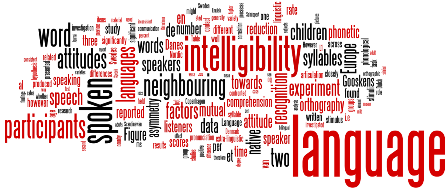
Mutual intelligibility
of closely related languages
MICReLa

Play our popular LANGUAGE GAME right here!
How well can people understand a language that is closely related to their native language? The MICReLa research group, based at the University of Groningen, developed an online game to investigate this matter. To make a meaningful analysis, they need more than 24.000 participants from 16 countries.
English does not always work
In order to communicate within Europe, many people learn English. Yet, a lot of people still do not speak English sufficiently well. An alternative for using English might be receptive multilingualism. Speakers of two different, but related languages both speak their own language and are still able to understand each other to a certain extent. Receptive multilingualism is possible when languages are mutually intelligible.
Scandinavia
Languages that are mutually intelligible are closely related to each other. The Scandinavian languages for instance, are mutually intelligible to a high degree. Therefore receptive multilingualism is already widely used in Scandinavia. The advantages of this way of communicating are that the speakers only need to focus on understanding the other language and that they can express themselves in their native language.
Online game
The MICReLa research group investigates how mutually intelligible European languages are and which factors influence the mutual intelligibility of languages. They developed an online language game in which people can test how well they understand a related European language. The group will use the results of this game for their intelligibility research. The game can be found via this link: http://www.micrela.nl/app/.
Language groups
Participants with all kinds of backgrounds can participate; the only criterion is that they speak a European variant of one of the languages below. There are 16 languages in three language groups involved in the game: Germanic, Slavic and Romance. Participants of the language game can win various attractive prizes.
The following languages are included in the game: Bulgarian, Croatian, Czech, Danish, Dutch, English, French, German, Italian, Polish, Portuguese, Romanian, Slovak, Slovene, Spanish and Swedish.
In Europe a large number of languages are spoken. These languages enjoy different statuses, some are officially recognized, while others are spoken by minority populations. Respect for linguistic diversity is a core EU value but the linguistic diversity can lead to communication problems that might only be reconciled with sufficient knowledge about the language situation at hand. In 2007 the High Level Group on Multilingualism (HLGM) therefore published an overview of research topics that should be investigated to improve communication within Europe while still preserving multilingual richness. Two of these topics form the basis for the present investigation. Firstly, the HLGM notes a lack of knowledge about mutual intelligibility between closely related languages in Europe and the lack of knowledge about the possibilities for communicating through receptive multilingualism, i.e., where speakers of closely related languages each speak their own language. Secondly, the HLMG notes a need for an evaluation of the potentials and limitations of the use of English as a lingua franca at the European level. More knowledge is needed about how well speakers of various languages in Europe understand each other in English. We propose a large-scale investigation of the mutual intelligibility of closely related languages within the Germanic, Slavic and Romance language families. The results will be correlated with linguistic factors, such as phonetic and lexical distances, as well as extra-linguistic factors, such as language attitudes towards and familiarity with different languages. Tests will also be carried out with English as a Lingua Franca (ELF) to compare the (mutual) intelligibility of closely related languages with the (mutual) intelligibility of ELF as spoken by the same groups of speakers. Intelligibility, attitude and familiarity tests will be carried out by means of web-based experiments. The results will be will be made available through the internet. They will provide a basis for developing a model that explains mutual intelligibility between closely related languages. In a more general sense the results will provide a greater understanding of the robustness of the human language processing system. How deviant can a language be before it is no longer intelligible to the listener? The results will also be of great value to European policy makers. A publicly available user-friendly internet application will be developed for use by future target groups of researchers and policy makers. In this way additional languages can be tested later that were not initially included in the project.
Contact: Charlotte Gooskens
Linguistic determinants of mutual intelligibility in Scandinavia (NWO Vidi, 2006-2011)
The three mainland Scandinavian languages, i.e. Danish, Swedish and Norwegian, have a reputation of being mutually intelligible, which means that the speakers are able to communicate each using his or her language. However, in daily practice inter-Scandinavian communication sometimes fails. The results of a number of studies have shown that especially Danes and Swedes have difficulties understanding each other's language. The problems are commonly explained by extra-linguistic factors such as linguistic experience and language attitude. Linguistic explanations have mostly been neglected due to the lack of a suitable method for quantifying linguistic distance. Recently, such methods have been developed. The aim of our project is to use these newly developed methods and refine them in order to be able to measure communicatively relevant linguistic distances among the spoken Scandinavian languages. On the basis of these measurements, a model is developed that explains mutual intelligibility in Scandinavia. This model is also applied to investigate intelligibility between other Germanic languages. Research is also being conducted into intelligibility between Dutch, Flemish and Afrikaans varieties.
This project is funded by the Netherlands Organization for Scientific Research (NWO)
Contact: Charlotte Gooskens
Last update: 11.09.2012